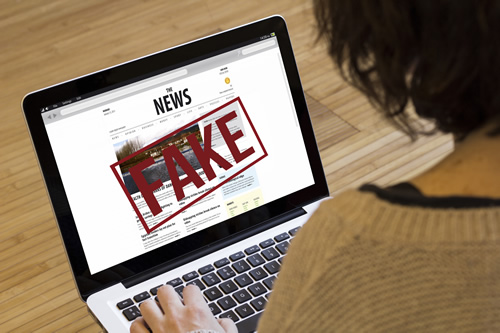In the 1930s, Upton Sinclair was one of the most prominent writers in the United States. But no amount of fame could protect him, when he ran for governor of California, from “one of the most well-orchestrated smear campaigns in American history,” instigated by political and business interests hostile to the muckraking revelations in Sinclair’s books, such as The Jungle, making him a victim of “a forerunner of [the] ‘fake news’” that’s so pervasive today.
Nor was he the first American to be misrepresented by his adversaries: John Adams and others in colonial and post-colonial times often felt abused by an unfettered free press.
Call it fake news, propaganda, disinformation–it’s been with us in some form or another as long as the written word and doubtless in the oral tradition before that, in whispering campaigns and word-of-mouth slander.
Related content: How to fight fake news
But what’s happening today is different.
The disinformation campaigns of the past were hard to execute – they required significant effort and money, brick-and-mortar operations, were often limited to print, and even on radio and TV were centrally orchestrated. The near-zero cost of publishing and distributing has made creation and dissemination of misinformation a lot easier at scale.
The algorithms and AI that power the digital experiences today also seem to gravitate towards content that is popular, and they are unable to distinguish between relevant and right information. Unlike controlled media where it is possible to retract or correct information and reach the affected population, digital media today is more of a consume-and-go experience, creating echo chambers and bubbles.
And as if this weren’t enough, the fake news world is likely to be on steroids thanks to “deep fakes”–videos depicting things that look real but aren’t. We may soon find ourselves in a world where we can’t distinguish real from fake with any reasonable certainty.
Why is this happening? To start with, there’s the fact that the internet isn’t edited – anyone can post anything they want there. Everyone there is a publisher. The most popular content, not the most valuable or vetted, shows up at the top of search results, and that’s what people see. It’s no surprise, then, that, according to a recent MIT study, false information spreads 70 percent faster than true information.
The problem is so pervasive that the British newspaper The Independent has a whole page devoted to news about fake news, along with Mashable and a growing number of others.
Rumors and sloppy, irresponsible, unvetted content are endemic to the online world and to social media platforms like Twitter and Facebook. People have even been killed in India based on rumors spread via WhatsApp.
Not all the false information on the internet is deliberately false. Some of it is poorly sourced, poorly edited, or poorly fact checked. This is true on many, though by no means all, crowdsourced sites and blogs. Limited adherence to a journalistic code of ethics (seek truth and report it, minimize harm, act independently, be accountable and transparent) tends to produce unreliable content.
The need for information literacy
In the bygone era when most kids used textbooks, reference works, and other sources that had undergone responsible editing and a review by educators before they were adopted, the need for students to look at their sources skeptically was not as great. Today, it’s different. Students use the internet constantly for research, and even the most concerted efforts by teachers and parents to steer kids to reliable sources can’t keep them away from bad content all the time. Sometimes they’re on their own, and they’ll be on their own more and more as they get older. They have to master information literacy, the savvy skill of spotting false information, identifying good information, and understanding the difference between the two. It’s a skill that doesn’t come naturally; it has to be taught.
Students say finding the truth is a long, boring “20-minute process,” but their attitude changes if given the right tools, according to a 2018 Knight Foundation Study.
Media literacy is a key 21st-century skill, and it is critical to strengthen critical and cognitive thinking and inoculate against misinformation.
Fighting the fake: Who’s stepping up?
While it may seem at times as if the internet is simply awash in misinformation, the good news is that there are people and organizations fighting the trend and developing resources for parents and educators who are on the frontlines. I’m proud to say that Britannica Digital Learning, our K-12 division, is one of them.
In the recent “Fight the Fake” series on the Britannica education blog, the eminent school librarian Tiffany Whitehead outlines a number of strategies for teaching and practicing information literacy, such as “Choose your sources wisely: Try to track down primary or authoritative voices, like scholarly journals or government databases, rather than second-hand reports.”
Other groups working to combat fake news include:
a. Snopes
b. NiemanLab
c. Poynter Institute’s Politifact
d. FactCheck.org
Curiosity is critical
Fake news is here to stay. We all need to address both the supply and the consumption sides. We can start with awareness and a few rules about how we “publish” online: don’t litter the web with bad information; don’t spread or share information if you aren’t sure about it (cut the oxygen for fake). And be mindful of how we consume information: practice media literacy with tools such as “the 5 Ws.”
Human curiosity is paramount in this battle against misinformation. Curiosity drives learning and stimulates the critical attitude that questions the intent and source of information. We need everyone engaged in probing and questioning for the truth to prevail. There is no better immunization against misinformation than reactivating our curiosity shield.
- High school students say AI will change the workforce - April 18, 2024
- Motivating students using the Self-Determination Theory - April 17, 2024
- Michigan Virtual’s statewide workgroup releasing AI guidance for K-12 educators - April 17, 2024

